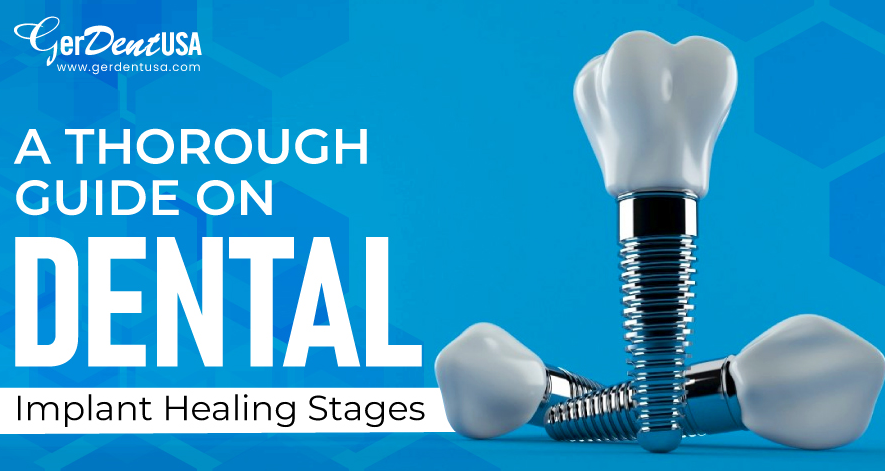Recent studies by the American Academy of Implant Surgery show “dental implant procedures have 95% success rates” These statistics prove that dental implant is an effective and safe restorative dental procedures. Here, many questions will be bulging in your mind about this treatment, like why people need this dental treatment and how it works.
This blog will cover a dental implant procedure, mainly its 4 critical dental implant healing stages. So, you will get all the answers about this procedure in this blog. Therefore, let’s first understand this procedure in detail.
Table of Contents
What is a Dental Implant Procedure?
A dental implant procedure is a restorative dental treatment that replaces lost, decayed, damaged, or impacted teeth by inserting implants into the jawbones. It is a safe and efficient treatment when traditional bridges and dentures fail to recover missing or rotten teeth.
Dental implants are titanium structures that dentists place at the teeth site, which need to be removed. These structures act as an anchor for artificial teeth or crowns and are connected through the abutment. Most importantly, the jawbone must be strong for a successful dental implant.
Next, have a look at the advantages of this procedure.
Benefits Of Dental Implant Procedure
The dental implant procedure lasts longer than other dental implant procedures. Besides, it can easily last for 15-20 years following the appropriate care and maintenance tips. It also doesn’t result in severe complications.
What Are the Stages of Dental Implant Procedure?
The dental procedure comprises the following stages:
- Initial Assessments
- Placing dental implants and bone grafting
- Placing abutment
- Crown fitting
- Healing
In addition, dental implants are of two types: Endosteal implants and Subperiosteal implants. The selection of the procedure depends on the strength of the jawbone. However, the healing process is the same in both these types.
So, let’s talk about the healing stages of dental implant procedures in detail.
Four Dental Implant Healing Stages
The healing time of a dental implant procedure varies from patient to patient, depending upon the following factors.
- Patient age
- Medical history
- Jaw health condition
- Types of materials used for dental implant
The recovery time also depends upon how strong the patient’s jawbone is. Patients with strong jawbones usually take less recovery time. Nonetheless, the subsequent recovery stages are the same for all patients.
- Post-Surgery Healing
Post-Surgery healing is the first stage among dental implant healing stages that involves taking care and rest after treatment. Orthodontists advise patients to avoid eating crunchy or hard food, physical activity, and smoking.
The patient may also feel swelling at the implant site, which may cause discomfort. It can last for a few days to weeks depending upon the severity of the swelling. In such circumstances, take the medication regularly and rinse the mouth with salt solution or antibacterial mouthwash.
Besides, following the dentist’s instructions carefully is mandatory.
- Healing Of Soft Tissues
This healing stage is characterized by swelling and redness around the dental implant area. It may last for two to six weeks for swelling to go down. During this phase, the patient should avoid physical movement and take plenty of fluids, especially water.
Rinsing the mouth with a saltwater solution or antibacterial mouthwash doesn’t allow pathogens, especially bacteria, to grow. Hence, it helps fast heal soft tissues after dental implant treatment.
- Bone Healing and Adjusting to Dental Implant
Adjusting to dental implant and bone healing is the third step of the dental implant healing stages. Depending on the patient’s history, age, and jaw health conditions, this healing process can last weeks to months.
Avoiding physical activity and smoking helps to health fast. Also, drinking plenty of fluids and eating a healthy diet fastens healing time.
However, the most crucial thing during all these healing stages is taking care of the implant area. So, let’s discuss some maintenance tips in the following paragraphs.
Effective Tips for Quick Dental Implant Recovery
As we have already discussed, the recovery time of dental implants is different for different patients.
- Proper Rest
Dentists advise proper rest to patients for effective results of dental implant healing stages. Physical exertion can delay the healing process or affect dental health.
- Follow Check-Ups
It is indispensable to follow check ups regularly after getting the dental implant treatment. Additionally, the patient should avoid smoking and completely follow the dentist’s instructions for more effective and faster healing results.
- Protect Blood Clots Around the Healing Site
Typically blood clots form around the surgical site as part of the implant healing process. So, it’s vital to protect them from any damage and clean them with mouthwash and saltwater for a few days after dental surgery.
- Take Medicine and Apply Ice to Reduce Pain
The dental implant is a painful procedure, and recovery is also time-taking. So, it is advised to take medicines according to the dentist’s prescription in case of pain. However, applying ice if suffering from severe pain is best, and consult your orthodontist immediately.
Want A Quick Recovery for Your Patients?
A dental implant procedure is highly effective for replacing missing or decayed teeth. The treatment comprises different pre- and post-operational stages. Further, there are four main dental implant healing stages after which the patient can smile big more confidently.
If you are a dentist and want your patients to smile confidently and recover soon from dental implant procedures, it is only possible by using high-quality instruments. For getting such dental tools, you may consider GerDentUSA. They have been manufacturing and supplying dental tools for the last three decades.
Above all, they have a wide range of dental instruments, along with multiple variations of some of them. Most of them are German-forged and have high tensile strength. They are also resistant to rust and corrosion and require low maintenance due to their high-quality manufacturing material.

